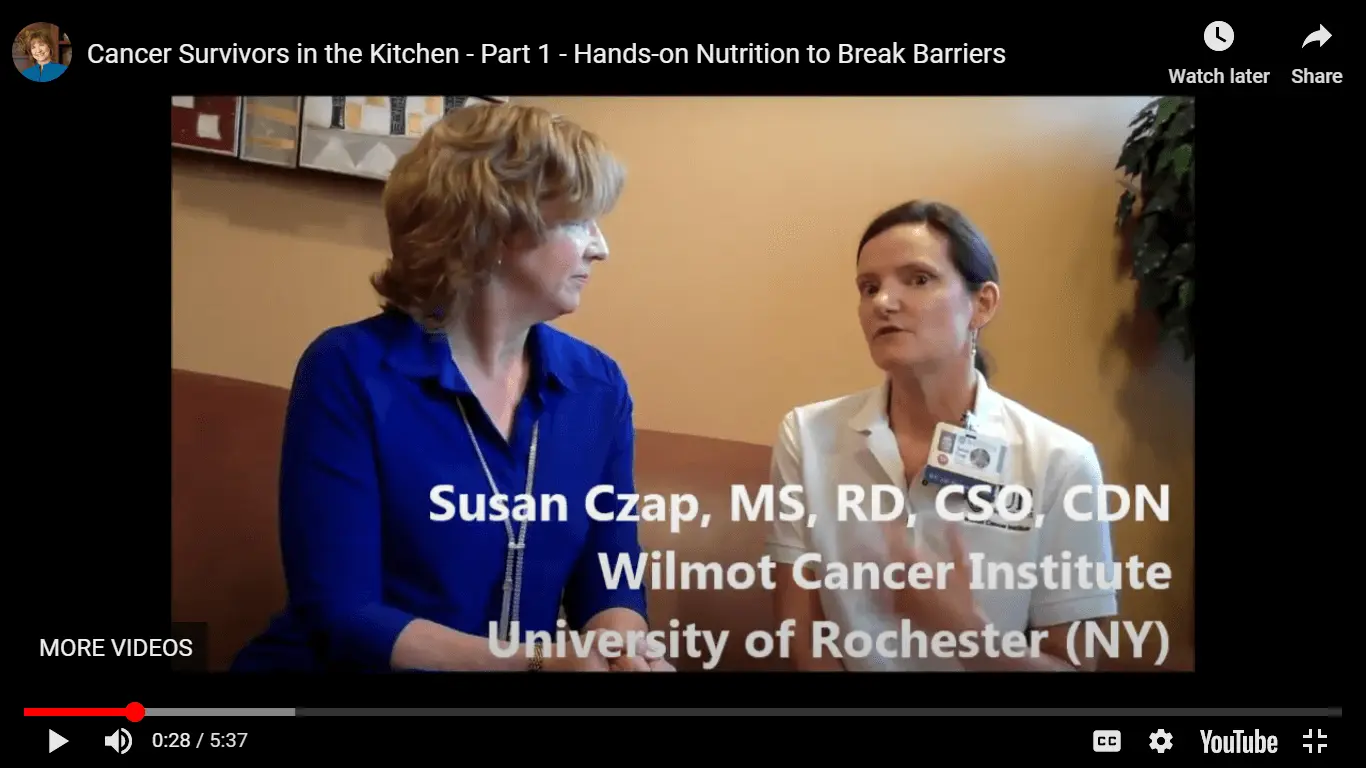
Cancer Survivors on Nutrition: Show Me, Don’t Tell Me
During and after treatment, cancer survivors can face appetite and taste changes and intense fatigue that pose challenges to intentions for healthy eating. A growing number of cancer treatment centers and survivorship programs are taking a new approach to help people avoid the toll that can take on strength, vitality and even ability to continue a plan of treatment.
Going beyond talking about eating choices, these programs are actively engaging people in the kitchen so they can judge food taste and preparation effort for themselves.
One such program is held at the Gilda’s Club in Rochester, New York, in conjunction with Wilmot Cancer Institute at the University of Rochester Medical Center, with support from the Pluta Cancer Center Foundation. Here, in part one my video interview with Sue Czap, MS, RD, CSO, you can hear firsthand about a cooking class in which cancer survivors and family members come together to cook and enjoy new foods.
Watch the video, then read on for more about this growing trend in cancer survivorship programs.
Culinary Translation Workshop
I learned about the Rochester program when its leader, Sue Czap, attended a culinary translation workshop I help lead. The Washington, DC, workshop is conducted as a joint effort of the American Institute for Cancer Research (AICR) and the Smith Center for Healing and the Arts. Key to its success is the expertise of Laura Pole and Ruth Fehr, two terrific chefs experienced in working with people during cancer treatment.
The Rochester program Sue discusses in the video here offers a cooking program once a month. People get to sample different foods each time. On the day I visited the Wellness Cooking Class, Sue provided a brief learning session on seeds, including chia seeds and quinoa. (Yes, we use quinoa like a grain, but botanically it is a seed.) Then everyone divided into groups of 3 to 4 people and the cooking began.
The program theme changes each month. On the day I visited, it was oriented to Mexican flavors. The menu: one-pan Mexican quinoa; wholly guacamole; sweet potato, jicama and pineapple salad; Mexican cucumber salad; and mango chia pudding for dessert.
Programs like this at cancer treatment centers, survivorship programs and community centers can vary widely. Some, like the Rochester program, have a large enough kitchen that participants all roll up their sleeves and cook. Other programs feature cooking demonstrations, often followed by taste testing.
Cancer Survivors Changing Habits, Breaking Barriers
Preparation time can seem a major barrier to healthy eating, especially for the many cancer survivors who feel low on energy for their busy schedule or experience profound cancer-related fatigue. Culinary programs for survivors can show how simple preparation and well-chosen frozen or canned foods, when combined with easy flavor enhancers, allow quick-and-easy to also be healthy and delicious.
Individualized flavoring can allow people with taste changes resulting from cancer or its treatment to enjoy healthy food. Unpleasant bitter tastes, sensitivity to sweetness, mouth or throat sores, and other challenges can all be addressed with kitchen tweaks.
No-pressure testing of new foods and cooking techniques provides a chance to sample new options without worries of what to do if a food doesn’t meet their expectations or those of others who eat with them. Cancer survivors, just like other people, may have been in a rut with limited variety of vegetable and whole grain selections. Getting to try roasted vegetables, herbs or fruit zest as flavoring, and unfamiliar grains, pulses and other healthful foods breaks down many barriers.
Side effects of cancer or its treatment can often be helped by targeting choice of foods, flavorings and preparation. For example, when food seems to have no flavor, lemon, fruit marinades and increased herbs and spice helps. For problems with “off flavors”, citrus, vinegar, fruit salsa, and feta or Parmesan cheese may help. However, if someone has mouth or throat sores, then acid flavorings like citrus and vinegar should be avoided. Cumin (a spice), sweet and sour sauce, or a bit of honey or maple syrup can help cut through a metallic or bitter taste. When metallic taste is a problem, fish, poultry, eggs, cheese, beans and nuts are often better tolerated than red meat. For people with diarrhea, bananas and applesauce, as well as the cooking water from preparing rice can help.
Bottom Line on Cancer Survivors & Nutrition:
The emerging trend of hands-on cooking classes for cancer survivors is an exciting way to bring nutrition to life. People can see past barriers that seem to be in their way, and the fellowship found there likely plays a powerful role. Come back for part 2: Sue Czap will share tips on whole grains and legumes (dried beans and peas), vegetable variety, and making healthy food flavorful.
For tips on eating choices to deal with side effects of cancer and its treatment, check the “Eat Right to Fight Cancer” section of the Oncology Nutrition Dietetic Practice Group website. This is the home of registered dietitian nutritionists who specialize in cancer-related nutrition.
The Essential Cancer Treatment Nutrition Guide & Cookbook. Jean LaMantia, RD. Toronto: Robert Rose, 2012.
What to Eat During Cancer Treatment: 100 Great-Tasting, Family-Friendly Recipes to Help You Cope. Jeanne Besser, Kristina Ratley, Sheri Knecht, Michele Szafranski. Atlanta, Georgia: American Cancer Society, 2009.
*I do not receive any income or reward for sales of these books. I share them only as resources some people may find valuable.
3 Comments
Leave a Comment
Published : June 27, 2017
Tagged: cancer patients, cancer survivors, cooking class, culinary workshop, healthy eating, Susan Czap, video interview
Meet the author/educator
I Take Nutrition Science From Daunting to Doable.™
As a registered dietitian nutritionist, one of the most frequent complaints I hear from people — including health professionals — is that they are overwhelmed by the volume of sometimes-conflicting nutrition information.
I believe that when you turn nutrition from daunting to doable, you can transform people's lives.
Accurately translating nutrition science takes training, time and practice. Dietitians have the essential training and knowledge, but there’s only so much time in a day. I delight in helping them conquer “nutrition overwhelm” so they can feel capable and confident as they help others thrive.
I'm a speaker, writer, and nutrition consultant ... and I welcome you to share or comment on posts as part of this community!




Video was so incredibly inspiring and I hope to do something like that for my foundation. Hands-on make a huge difference. I agree with all points but especially how empowering it is to give cancer patients to tools to be proactive with their meals.
I agree, Wendy! Visiting this program run by Sue Czap and her team was certainly inspiring to me. But then, I see many oncology dietitians (like you!) serving their patients in a variety of inspiring ways.
[…] part one my video interview with Sue Czap, MS, RD, CSO, you heard about a cooking class for cancer survivors and their family […]